|
|
|
|
|
|
|
|
|
|
|
|
|
|
|
|
|
|
|

|
Current Exhibitions Future Exhibitions Back to Exhibitions 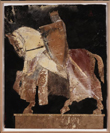 Miguel Zapata. Golden King, 2001. Mixed media, 69.5 x 58 inches. On loan from the Collection of Frederick Merrill, Jr., Dallas
Miguel Zapata. Golden King, 2001. Mixed media, 69.5 x 58 inches. On loan from the Collection of Frederick Merrill, Jr., Dallas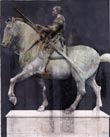 Miguel Zapata, Gatta Melata, 2001. Mixed media, 68 x 52 inches. On loan from the Collection of Brian McCall, Plano, Texas
Miguel Zapata, Gatta Melata, 2001. Mixed media, 68 x 52 inches. On loan from the Collection of Brian McCall, Plano, Texas
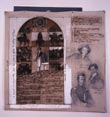 Miguel Zapata, Project for Texas Door, 2001. Oil on canvas, 77 x 79 inches. On loan from the Lex Johnson Republic of Texas Collection of The Oaks Bank & Trust Company, Dallas
Miguel Zapata, Project for Texas Door, 2001. Oil on canvas, 77 x 79 inches. On loan from the Lex Johnson Republic of Texas Collection of The Oaks Bank & Trust Company, Dallas
 Miguel Zapata, Anfora, 2003. Mixed media, 54 1/4 x 63 1/4 x 1 1/4 inches. Private Collection, Dallas
Miguel Zapata, Anfora, 2003. Mixed media, 54 1/4 x 63 1/4 x 1 1/4 inches. Private Collection, Dallas
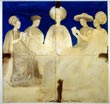 Miguel Zapata, Bridge Players, 2001. Mixed Media, 58 7/16 x 60 1/2 inches. Private Collection, Dallas
Miguel Zapata, Bridge Players, 2001. Mixed Media, 58 7/16 x 60 1/2 inches. Private Collection, Dallas
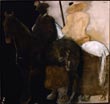 Miguel Zapata, Spanish Horsemen, 2003. Mixed media on canvas, 68 x 72 inches. Private Collection, Chicago
Miguel Zapata, Spanish Horsemen, 2003. Mixed media on canvas, 68 x 72 inches. Private Collection, Chicago
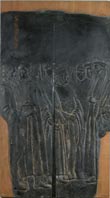 Miguel Zapata, Congregation, 1993. Mixed media, 55 x 31 x 1 1/2 inches. On loan from the Collection of Dr. and Mrs. Luis Martín, Dallas
Miguel Zapata, Congregation, 1993. Mixed media, 55 x 31 x 1 1/2 inches. On loan from the Collection of Dr. and Mrs. Luis Martín, Dallas
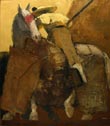 Miguel Zapata, El Picador, 2004. Mixed media, 46.5 x 43 inches. On loan from the Collection of Mr. and Mrs. Jason Nix, Dallas
Miguel Zapata, El Picador, 2004. Mixed media, 46.5 x 43 inches. On loan from the Collection of Mr. and Mrs. Jason Nix, Dallas
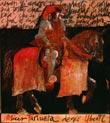 Miguel Zapata, Farinata, 2003. Mixed media, 57 1/2 x 51 1/4 x 1 1/4 inches. On loan from the Collection of B. Michael and Elise Chitty, Terrell, Texas
Miguel Zapata, Farinata, 2003. Mixed media, 57 1/2 x 51 1/4 x 1 1/4 inches. On loan from the Collection of B. Michael and Elise Chitty, Terrell, Texas
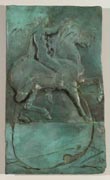 Miguel Zapata, Metopa, 1992. Bronze with green patina, 22 1/4 x 13 3/8 x 1 inches. On loan from the Collection of Dr. and Mrs. Robert Smith, Dallas
Miguel Zapata, Metopa, 1992. Bronze with green patina, 22 1/4 x 13 3/8 x 1 inches. On loan from the Collection of Dr. and Mrs. Robert Smith, Dallas
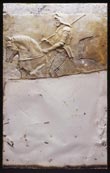 Miguel Zapata, Horseman, 2001. Mixed media, 39 x 25 inches.
Miguel Zapata, Horseman, 2001. Mixed media, 39 x 25 inches.
|
Miguel Zapata: Works from the Texas Studio October 14, 2004–January 30, 2005 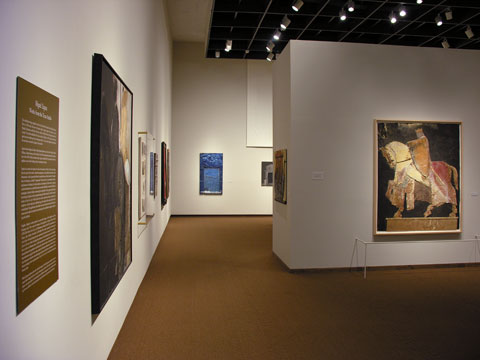 This exhibition brings together works by the celebrated Spanish artist Miguel Zapata. Born in 1940 in the old town of Cuenca, Spain, Zapata spent his formative years in Madrid, Barcelona, and Paris. He now resides in Madrid where his principal studio is located. The artist established his Texas studio in Dallas in 1991, and since then has spent several months each year working in the U.S. The works included in this exhibition are those executed in Zapata’s Texas studio. Zapata acknowledges his debt to older Spanish painters such as Antoni Tàpies, Manuel Millares, Antonio Saura, and Luis Feito, who led the subsequent generations to abstraction in the 1950s. With his distinct style, Zapata established his reputation in the mid-eighties as one of the leading artists of contemporary Spain. Zapata is an artist who chooses to work in the medium of history. He recoups images from the past in his works –often the masterpieces and architectural elements of the Renaissance– only to personify them by manipulations and interventions. He manipulates, for instance, a carefully “reproduced” historical frieze by intentionally introducing fissures or defacing it in what results as an abstraction. He intervenes by applying a bold brushstroke on a carefully, but not necessarily faithfully, resurrected Renaissance masterpiece, thereby boldly announcing his authorship. In thus appropriating images from the past, Zapata is always experimenting with different media. The richly textured surface of his bas-relief –which places his works somewhere between painting and sculpture– can be made up of cardboard, rag, silica mixed with varnish, plaster mold, or metal plate. The significance of his effort is as much in the end result as in the diverse means used to attain it; namely, the confounding of the established categories of painting and sculpture. Together, Zapata’s works present to us powerful imagery of the Spanish, and the European, past. This is seen, for instance, in the depiction of Alfonso VIII of Castilla (1155–1214) in the Golden King, or of the Venetian condottiere Erasmo da Narni (c. 1370–1443), in Gatta Melata, which is after the bronze equestrian monument called Gattamelata completed by the Early Renaissance sculptor Donatello between 1447 and 1450. No less lacking in power and beauty are the more recent El Picador and The Spanish Horsemen, both conveying the presence of that Spanish passion, the bullfight. Even in the two Kimono pieces, which may lead one to assume the evocation of the eternal Orient, the repetition of architectural motifs and friezes in the pattern points to their alternative origin for the artist; namely, the European Renaissance. We in Texas are also fortunate to find the artist directing his passion and talent to contemporary Texas history-making in the commemorative Project for the Texas Door and the accompanying bronze study. While Zapata embraces the rich cultural heritage of the European past in his works, we must acknowledge that he is a truly contemporary artist at the forefront of experimentation and exploration in subverting the established categories of art, and has opened up for us a distinct vista that demands careful attention and profound admiration. This exhibition was organized by the Tyler Museum of Art. Support for this exhibition has been provided in part by Valley House Gallery, Dallas. |